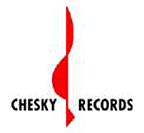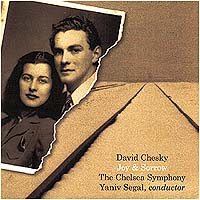

![]()

Joy & Sorrow
The Chelsea Symphony
Yaniv Segal, conductor
[JD371]
[ Binaural + CD ]
|
1. Dora's Dance 5;18 Concerto for Violin and Orchestra No. 3, “The Klezmer Concerto” in memory of William Noah Borkan Artur Kaganovskiy, violin 2. Movement 1 10:32 3. Movement 2 6:54 4. Movement 3 4:15 5. The Wiener Psalm 15:30 in memory of Gabe Wiener Ethan Herschenfeld, bass 6. Betty's March 6:13 7. The Fiddle Maker 6:51 Moran Katz, clarinet 8, Arbeit Macht Frei 15:18 Kristina Reiko Cooper, cello |
The works on this recording have accents that you can definitely hear in New York. But they have deep roots elsewhere — in some cases (“The Wiener Psalm,” for example) several elsewheres at once. Their strongest accent is that of klezmer, the Eastern European Jewish style that flourished in the early decades of the 20th century, and has enjoyed a revival (and an updating) in recent decades. This revival has taken place principally in the United States, where second and third generation Jewish musicians have become interested in exploring their grandparents' musical world, as a kind of personal and communal Roots Music. But klezmer has also come to life again in Europe, where the shtetls in which it had been the musical lingua franca were destroyed during the Holocaust. A second, and by no means unrelated current running through these works is the musical accent of the Roma — the gypsy style, as 19th century composers called it.
The album's centerpiece, the “Concerto for Violin and Orchestra No. 3 ‘Klezmer’” touches on both the joy and sorrow Chesky wanted to capture. The work is scored for solo violin and an orchestra that includes a prominent clarinet line, as well as trumpet, percussion, glockenspiel and the standard string complement, and bears the composer's direction, “Con espressione — play entire concerto in the Gypsy-Klezmer style.” It begins with the solo violin, deep in its range, singing a mournful, Hebraic melody, with more than a hint of a cantorial lilt. But this meditative opening gives way, suddenly, to brisk dance music — klezmer-like, certainly, but with a touch of Prokofiev's steeliness as well. That quality is quickly undercut by a fascinating exchange between the solo violin and the clarinet — not a dialogue, exactly, but rather, a series of brief provocations from the clarinet that push the violin to respond with increasing expansiveness, and ultimately a virtuosic cadenza. The clarinet phrasing is pure klezmer; the violin's lines draw more fully on the gypsy style, but eventually the two seem to become interchangeable.